Early in the morning, the shadows of pine trees stretch in long dark lines far across the wet prairie:
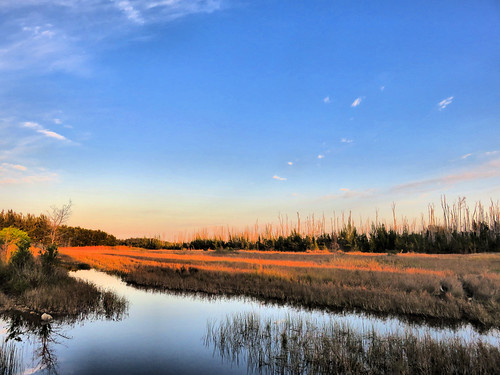
This photo has the rich warm colors of autumn, yet it was taken on the first day of spring. I was walking along a primitive farm road which runs due west, so the sun rose behind me and cast my shadow on the path ahead:
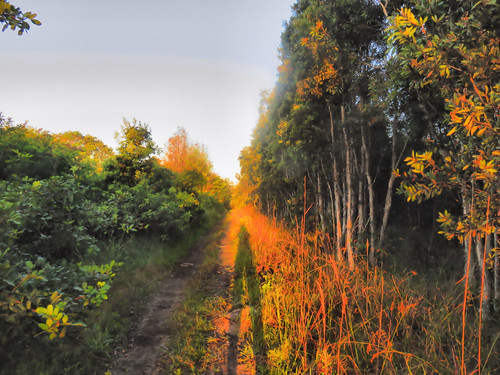
All generalizations are false, including this one-- "All white herons are egrets." True, here in south Florida the most common white heron in our local birding patch is the Great Egret, so graceful in flight:
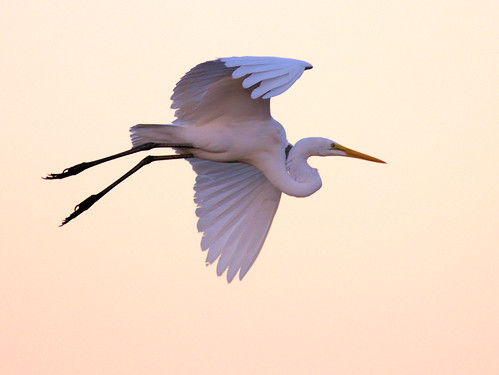
Egrets possess decorative fluffy plumes (aigrettes). Plumes, similar to the down which underlies the body feathers, lack the barbicels which link the fine branches of body and flight feathers together to form stiff vanes (Reference below).* This distinguishes egrets from others in the heron family, as demonstrated by this Great Egret:
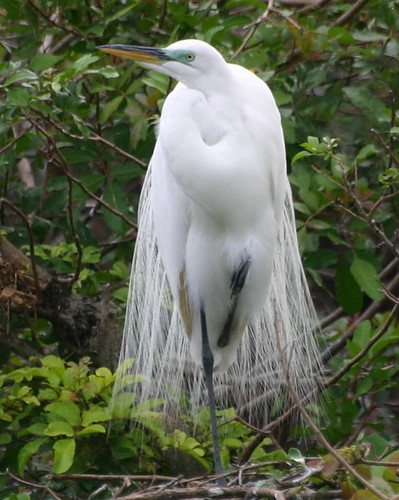
The Snowy Egret was hunted nearly to extinction for its plumes:
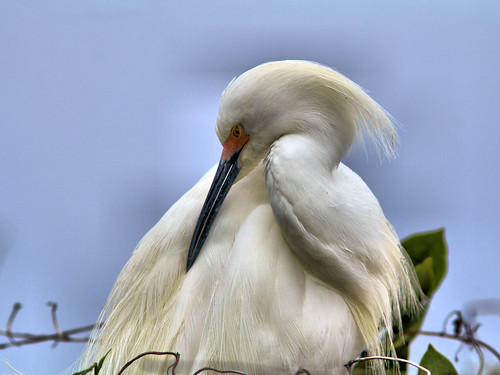
While the Great Egret has a long yellow bill and black legs, the much smaller Snowy Egret has a thin dark bill and bright yellow feet
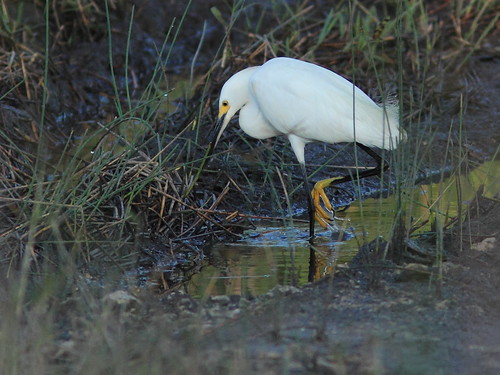
The small Cattle Egret is usually found away from water, has a short yellow bill and dark legs:
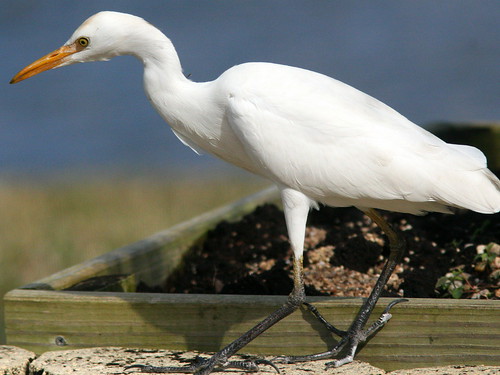
Pregnant cow with Cattle Egrets:
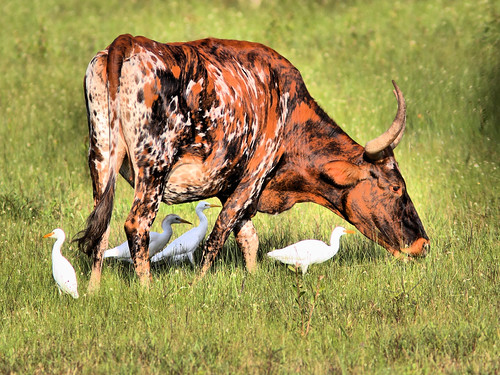
Cattle Egrets may perch on the backs of cattle, seeking insects such as ticks:

Not all egrets are white. While the large Reddish Egret has a white form, most have dark plumage:
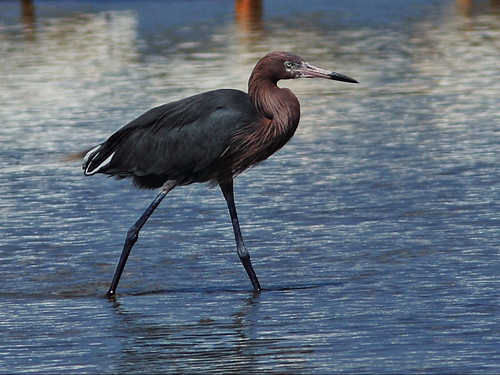
The white morph of the Great Blue Heron is white. Known as the "Great White Heron," it may be confused with the Great Egret. This one visited our back yard lake:

The Great White Heron's bill may be bright yellow like that of the Great Egret, but its legs are lighter in color, not black:
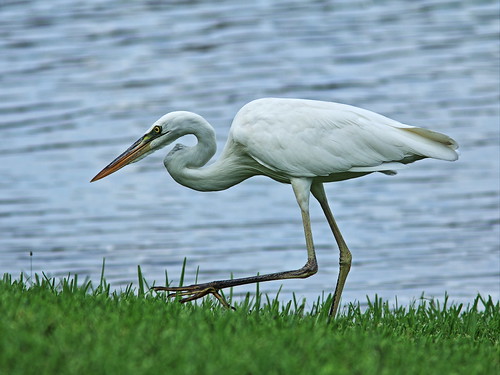
Another white heron which may be misidentified as an egret is the immature Little Blue Heron. Adults of this species are dark. It has greenish legs and a blue-gray bill with a black tip:
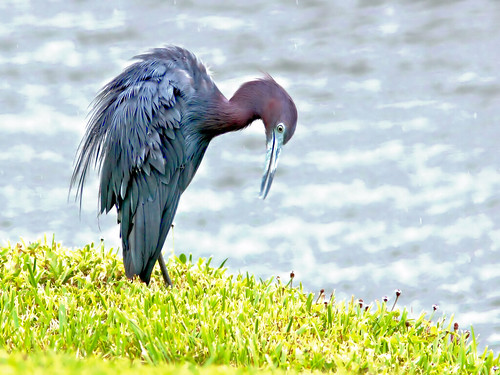
This immature Little Blue Heron is beginning to transform into adult plumage. Its face feathers are a bit dark, and it has scattered blue feathers:
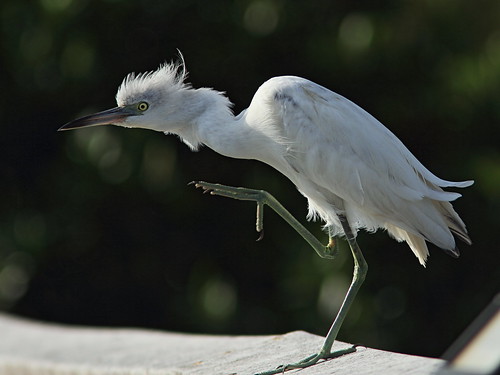
During its second year it becomes progressively darker as it molts:
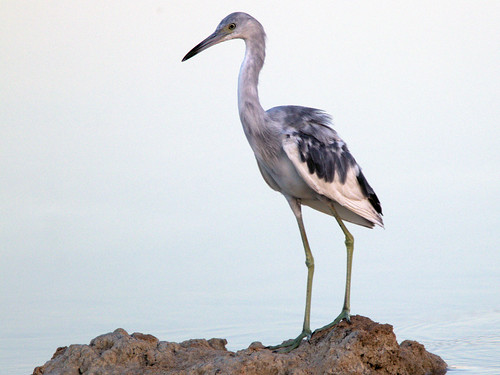
This produces some interesting color patterns:
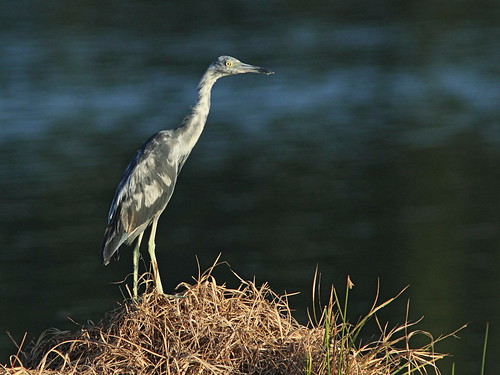
A Boat-tailed Grackle chases a Little Blue Heron which has a contrasting wing pattern:
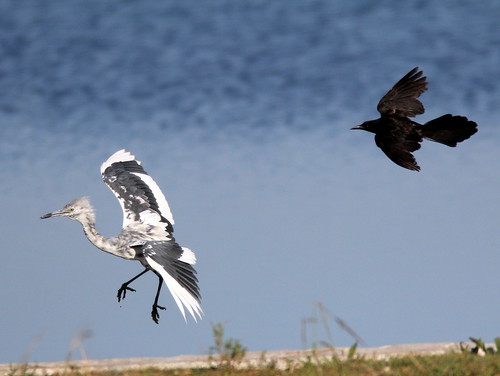
The graceful egrets make such delightful photo subjects:
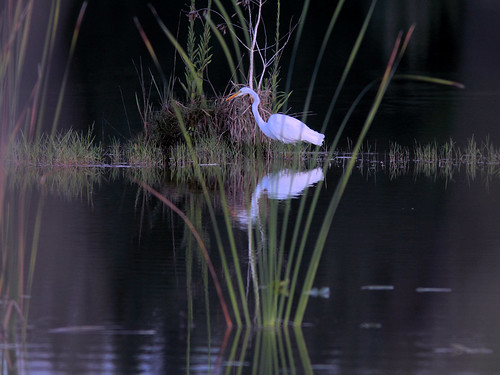
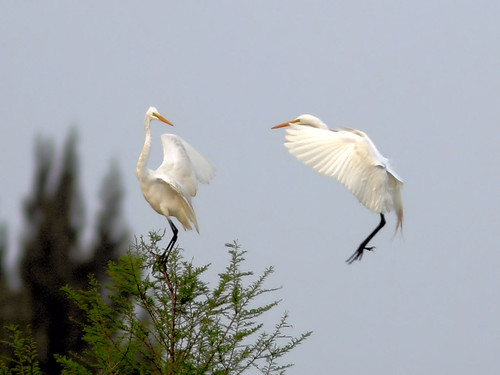
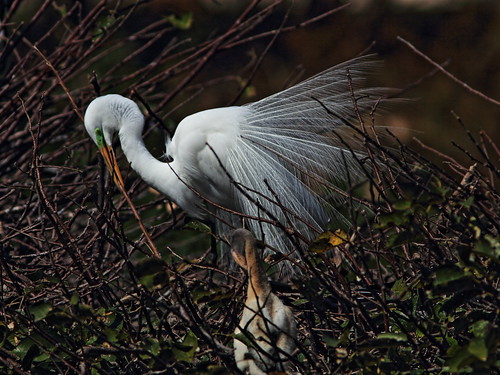
* There are two basic types of feather: vaned feathers which cover the exterior of the body, and down feathers which are underneath the vaned feathers... A typical vaned feather features a main shaft, called the rachis. Fused to the rachis are a series of branches, or barbs; the barbs themselves are also branched and form the barbules. These barbules have minute hooks called barbicels for cross-attachment. Down feathers are fluffy because they lack barbicels, so the barbules float free of each other, allowing the down to trap air and provide excellent thermal insulation. At the base of the feather, the rachis expands to form the hollow tubular calamus (or quill) which inserts into a follicle in the skin. The basal part of the calamus is without vanes. This part is embedded within the skin follicle and has an opening at the base (proximal umbilicus) and a small opening on the side (distal umbilicus). (Wikipedia)
= = = = = = = = = = = = = = =
Linking to Misty's CAMERA CRITTERS,
Linking to Eileen's SATURDAY'S CRITTERS,
Linking to GOOD FENCES by Gosia
Linking to SKYWATCH FRIDAY by Yogi, Sylvia and Sandy
Linking to WEEKEND REFLECTIONS by James
Linking to BirdD'Pot by Anni
Linking to Wild Bird Wednesday by Stewart
Linking to Wordless Wednesday (on Tuesday) by NC Sue
Linking to ALL SEASONS by Jesh
________________________________________________
Please visit the links to all these memes to see some excellent photos on display
________________________________________________
As usual, we got out early, about a half hour before sunrise, and hurried the half mile to the lake. Mary Lou had her customary head start as I stopped to take pictures. The full "Worm Moon" would set at almost the same time as sunrise, so it couldn't get much "fuller!"
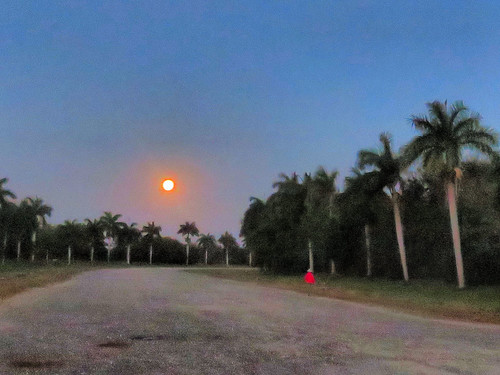
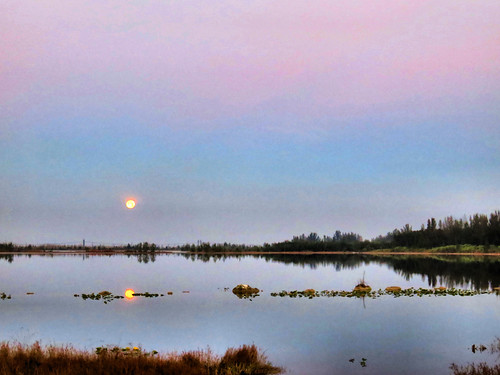 The next morning (February 13) we had time to wait for the Moon sink into the lake:
The next morning (February 13) we had time to wait for the Moon sink into the lake:
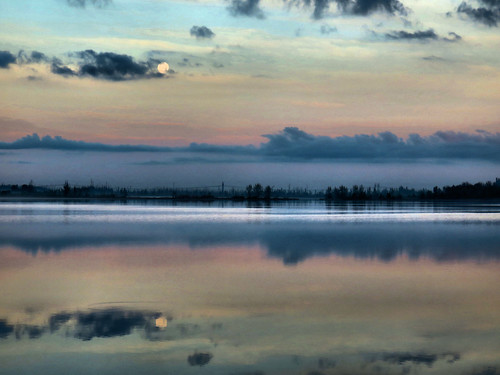
Luckily, the clouds held off a few more minutes and did not spoil the event!
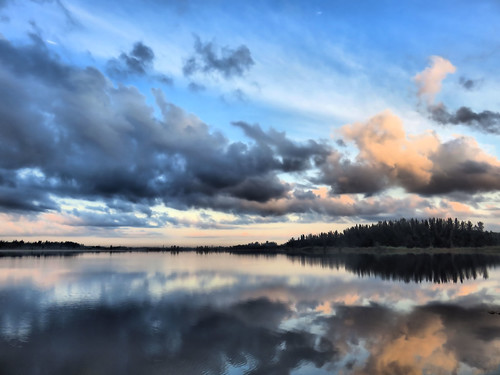
A Northern Mockingbird sang from a guard rail along the unpaved road:
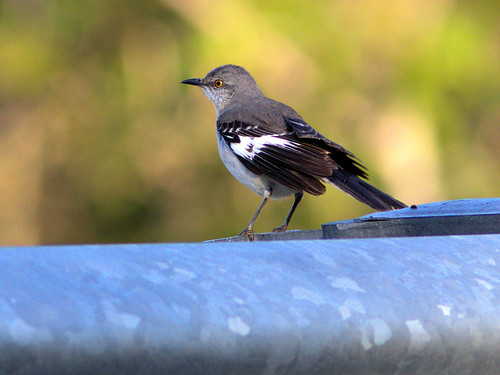 Here in south Florida there is no "spring chorus" of bird song as we had when I was a kid in New Jersey. The mockingbirds, cardinals and Mourning Doves all are singing in the dark as we walk out to the wetlands. Soon, Carolina Wrens and White-winged Doves join in before the jays and grackles try to spoil the symphony.
Here in south Florida there is no "spring chorus" of bird song as we had when I was a kid in New Jersey. The mockingbirds, cardinals and Mourning Doves all are singing in the dark as we walk out to the wetlands. Soon, Carolina Wrens and White-winged Doves join in before the jays and grackles try to spoil the symphony.
Our most common resident vireo sings all winter long. It is also a favorite photographic subject, although often very hard to locate. The White-eyed Vireo's song may sound tantalizingly close, but it has the habit of hiding in the thickest shrubbery and moving slowly and methodically through branches and leaves, in search of insects. It has provided me the best photo opportunities when I was not even looking for it.
On February 15, 2017 I was trying to track down a wren which was scolding from the middle of a patch of Lantana. I was moving about to get a better view when suddenly I saw a small bird sitting very quietly, only about 10 feet in front of me. It was in deep shade and I had not adjusted my exposure settings, so my images needed extra processing (layering of three different exposures of the original RAW files) to bring out the colors:
Birds cannot smile, frown or wrinkle their brows, but it seemed to be asking: "What are you doing here?"
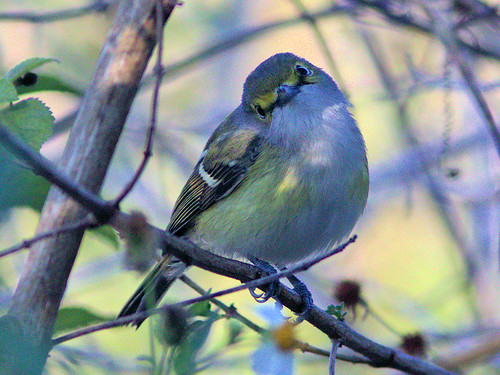
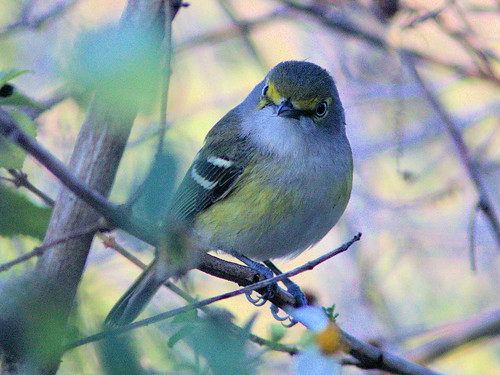
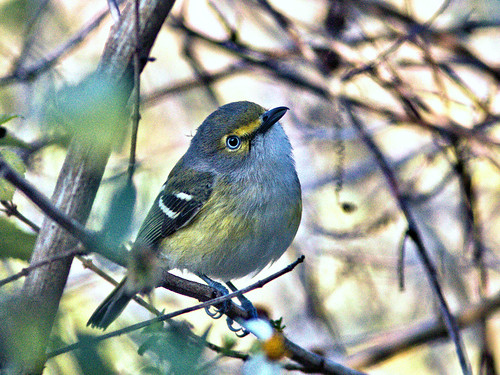
Oh, those eyes!
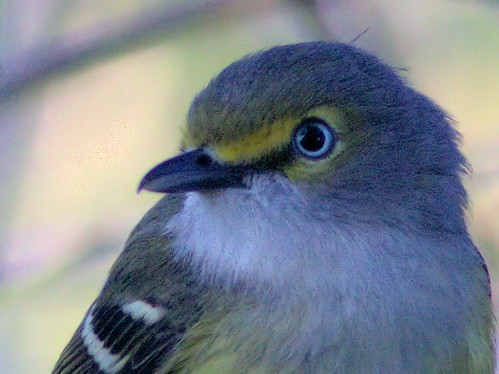
This White-eyed Vireo was intently searching for spiders out in the open and was not aware of my presence until about 1 second after I pointed my camera at it (February 16, 2017):
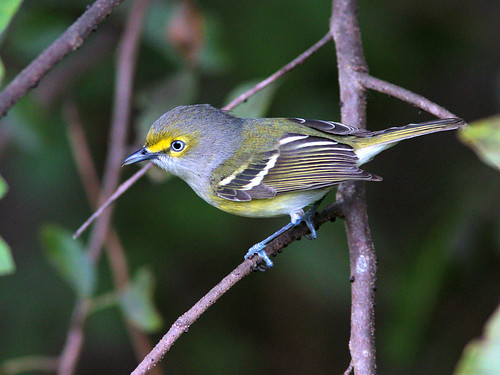

In this very same patch of Lantana, the White-eyed Vireo sometimes has an unusual companion which has attracted attention of many other birders. I'm not sure whether it has been the same individual, but a rather rare Bell's Vireo first showed up in this location in October, 2009, and then in three out of the past four winters. It usually arrived in October or November and lingered into January. This winter it appeared on November 7, 2016 and I saw it last on February 26, 2017. Over the past ten years there have been only a few other scattered reports of this species in our entire County.
Bell's Vireo is a plain-looking bird. Often in the company of a White-eyed Vireo, it is noticeably smaller and much more active, flitting from branch to branch, continually flicking its tail and wings. It has blue legs, faint whitish eye rings and a "spectacle" mark across its forehead, one prominent white wing bar and a shorter one above it. I have over two hundred images of this species in my archives, beginning with this, my first ever sighting, on October 23, 2009:
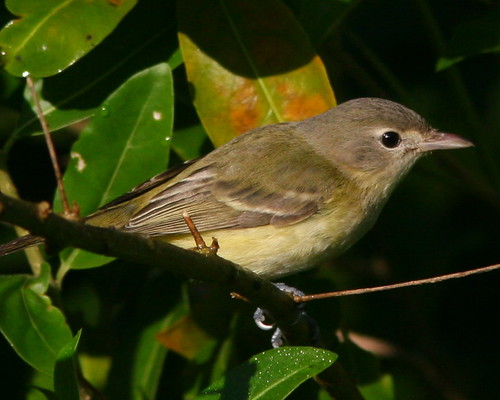
Bell's Vireo's breeding range is generally in the central and southwestern US. It migrates through Texas and Mexico to usual wintering grounds along the Pacific coasts of Mexico and Central America. A few wander eastward to spend the cold months along the gulf coasts of Texas, Louisiana, Alabama, Mississippi and Florida.
October 31, 2015:
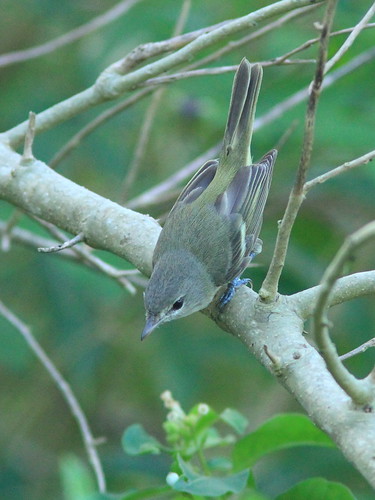
December 22, 2015:
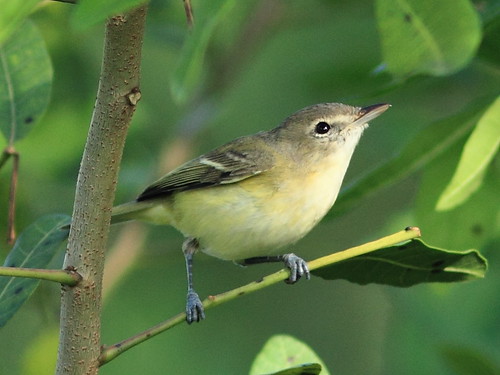 November 2, 2016:
November 2, 2016:
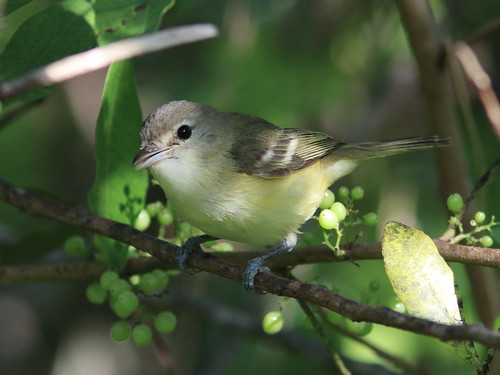
February 23, 2017:
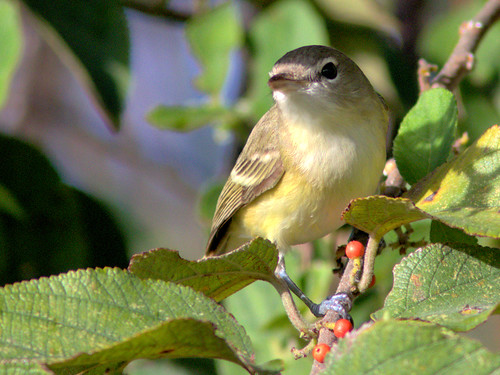
On the same day, eating Trema berries:
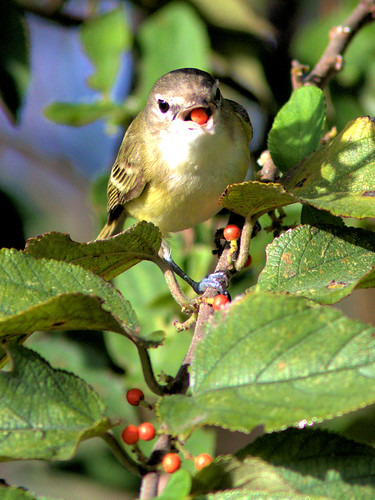
= = = = = = = = = = = = = = =
Linking to Misty's CAMERA CRITTERS,
Linking to Eileen's SATURDAY'S CRITTERS,
Linking to GOOD FENCES by Gosia
Linking to SKYWATCH FRIDAY by Yogi, Sylvia and Sandy
Linking to WEEKEND REFLECTIONS by James
Linking to BirdD'Pot by Anni
Linking to Wild Bird Wednesday by Stewart
Linking to Wordless Wednesday (on Tuesday) by NC Sue
Linking to ALL SEASONS by Jesh
________________________________________________
Please visit the links to all these memes to see some excellent photos on display
________________________________________________
The March full Moon, AKA "Worm Moon," creeps out from behind a cloud as we set out into the cool air a half hour before sunrise:
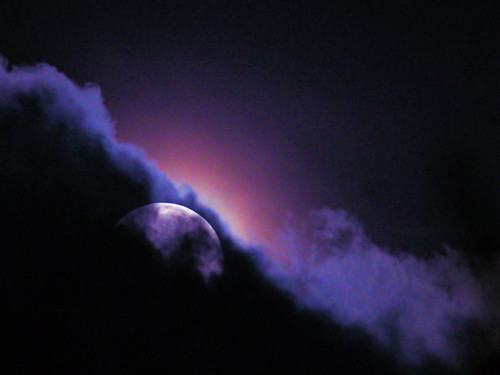
Spring is a time for departures as well as arrivals. New leaves and winged seeds appear on the Red Maples:
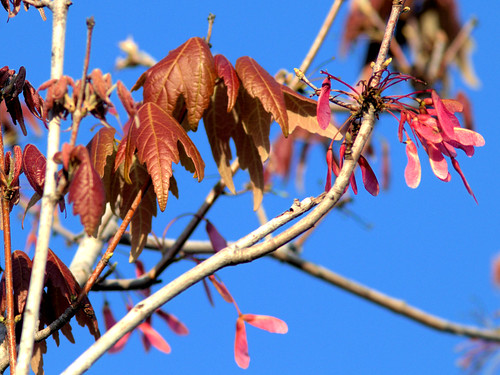
Winter residents are packing their bags and saying goodbye. We suddenly miss the rattling calls of the last Belted Kingfisher...
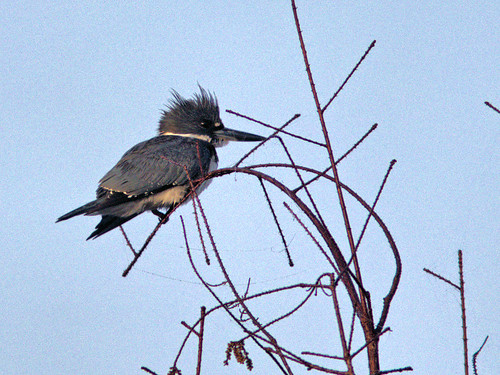
...and the bobbing tails of Palm Warblers :
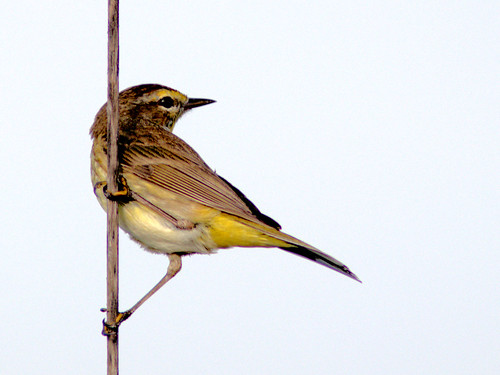
We will especially miss our wintering Painted Buntings. This male surprised me out in the wetlands by suddenly landing within camera range and sitting for a few seconds, just enough for me to obtain a portrait:
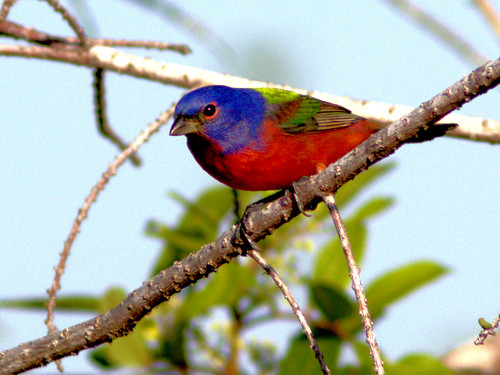
Yellow-rumped Warblers gather into flocks and soon disappear:
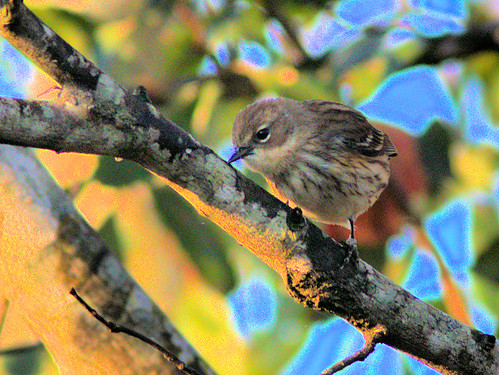
Some Black-and-White Warblers overwinter but their ranks are swollen by new arrivals who join them for a mass exodus:
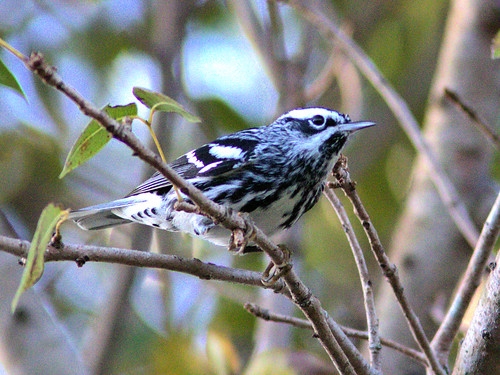
Most migrants are seen for a few days as they simply pass through on their way north. Northern Parula warblers arrive early:
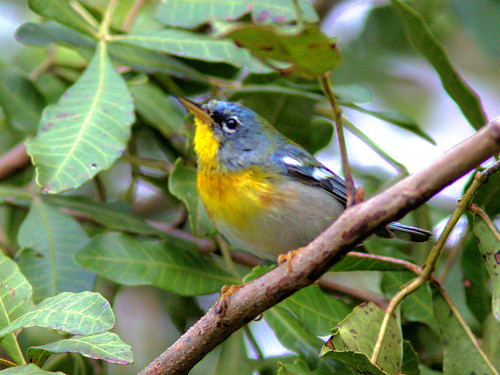
Resident birds undergo changes. Great Egrets sport plumes and the bald flesh in front of their eyes turns green:
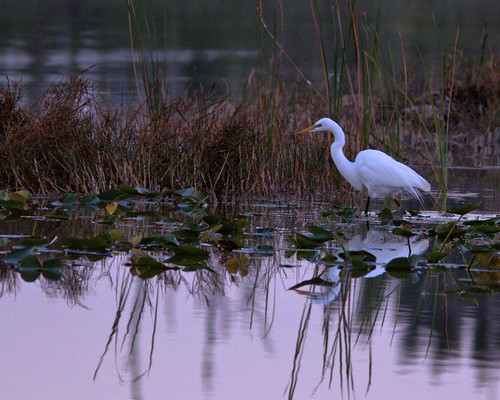
Male Red-winged Blackbirds stake out their territories in anticipation of the arrival of the females:
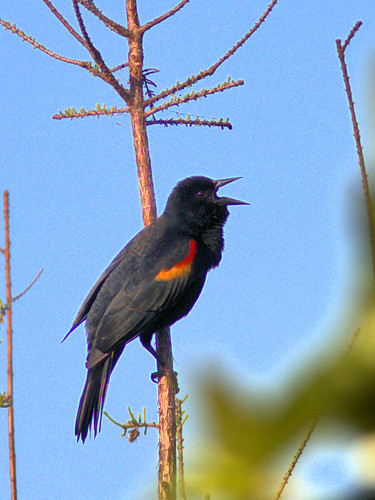
Yellow-crowned Night-Herons begin displaying before prospective mates:
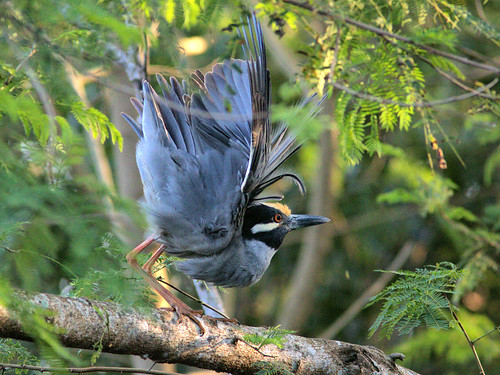
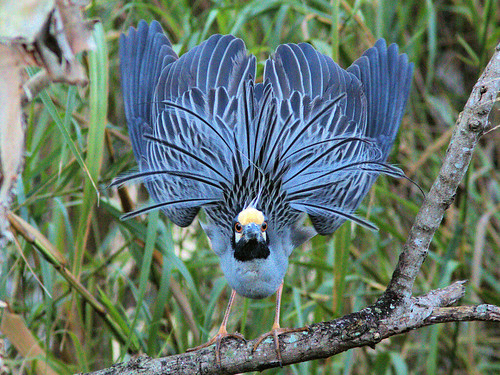
Our local Bald Eagles are nurturing two eaglets. They are a month or more behind schedule, as they lost their first two nestlings last year and raised a second brood. They were busy feeding and training the lone surviving eaglet well into September. This is probably why they delayed nesting by 4-6 weeks, but their two new chicks are growing rapidly:
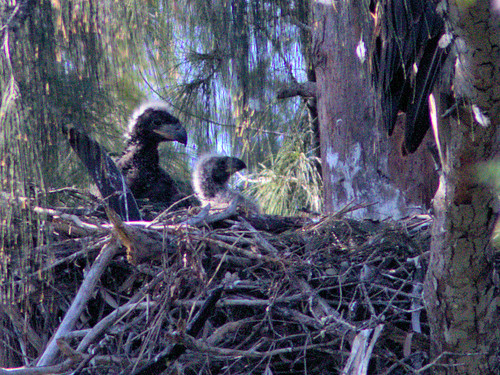
A mother Virginia Opossum guards her half-grown youngster next to our neighbor's fence:
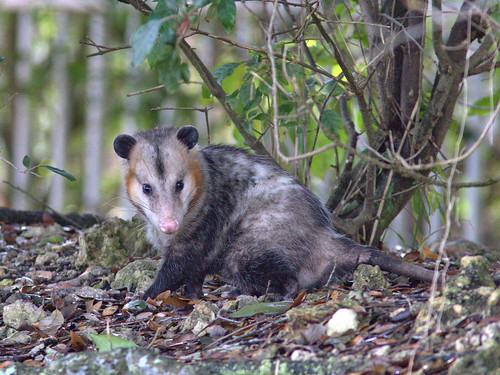
The little one seeks safety in a tree:
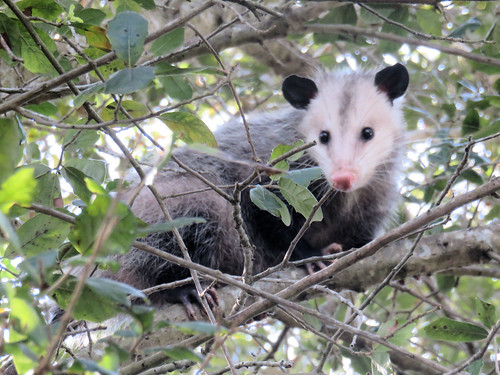
Thank you all for your expressions of condolences on the passing of Mary Lou's brother, Richard. She has lost three of her five brothers in the space of three years, beginning with Larry, who was my high school and college classmate, and Jack, who died only a few months ago. Sorry if I have been slow in catching up on correspondence but we so appreciate your concern.
= = = = = = = = = = = = = = =
Linking to Misty's CAMERA CRITTERS,
Linking to Eileen's SATURDAY'S CRITTERS,
Linking to GOOD FENCES by Gosia
Linking to SKYWATCH FRIDAY by Yogi, Sylvia and Sandy
Linking to WEEKEND REFLECTIONS by James
Linking to BirdD'Pot by Anni
Linking to Wild Bird Wednesday by Stewart
Linking to Wordless Wednesday (on Tuesday) by NC Sue
Linking to ALL SEASONS by Jesh
________________________________________________
Please visit the links to all these memes to see some excellent photos on display
________________________________________________



















































